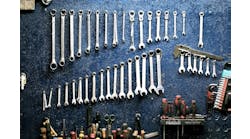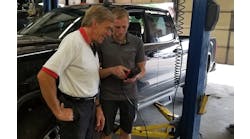If a piece of equipment is down in the shop, that’s time wasted. And any time wasted means no one in the shop is making money, says Chris Chesney, senior director of customer training at Advance Professional Driven by CARQUEST.
“It doesn’t help with top-line growth or bottom-line growth,” he says. “It’s simply flushing dollars down the drain.”
One way to eliminate that wasted time due to equipment in need of service is to implement an equipment upkeep policy. Chesney says the benefits of such a policy are numerous: It ensures safety, protects your investments, creates ownership among the staff and means that potential issues with equipment are more likely to be caught earlier. Throughout his training program work with CARQUEST, Chesney has helped shops around the country implement a similar policy and he breaks down the process for doing so.
AS TOLD TO ANNA ZECK
In order to eliminate the waste, you establish an equipment maintenance policy. This involves assigning one staff member to each large piece of equipment. The idea is to treat the equipment in the shop the way you’re asking your customers to treat their vehicles through preventative maintenance efforts.
The first step is that you have to identify the pieces of equipment in the shop. That would be any piece of capital equipment. That would include the tire machine, engine analyzer, gas analyzer, lifts, alignment machines, car washers, oor squeegee machines, air conditioning system, air compressor, waste oil furnace.
Then, you have to understand what each piece of equipment requires in the way of maintenance. That takes some work. All these pieces of equipment come with an owner’s manual that lists a maintenance schedule. Many of them
have videos that illustrate that and support teams that will guide you through that during installation. For example, instead of having a service rep come out and service the machine every time, why don’t you hire the service rep to come out once and show you how to service it appropriately? That way, you can ensure that the readout is zero so you know that everything is OK. Or, that it’s not zero and you know it needs to be serviced.
After that, create SOPs that really drill down into what needs to be done, step by step, to that piece of equipment. You want the person assigned to it to be able to perform that maintenance in a short amount of time, without wasting any time and ensuring the equipment is operating as designed. You should have what we call our standard work process. Create checklists that can be managed by the person who operates the machine and that act as documentation. Notes can be taken to log any faults or reminders that things are getting close to needing to be replaced so the order can be made today, rather than when it breaks down and you have to wait a few weeks to get the part. You’re creating a log for that piece of equipment.
Typically, you want to set a maintenance schedule based on a couple of different criteria. One is, how dirty does this piece of equipment get on a regular basis? Not only are we talking maintenance, but we’re also talking about keeping it clean. That person is going to make sure the piece of equipment is clean and lubricated. If you’re a brake shop and you do brake jobs every day, that equipment should be inspected every week, at a minimum, to identify those key elements or touch points that need to be checked on a weekly basis.
By assigning the upkeep of a machine to one employee, we have one person who takes ownership of that piece of equipment and ensures that the scheduled maintenance for that piece of equipment is carried out on time and accurately. So that when anyone in the building needs to use that piece of equipment, they’re con dent it’s working and it’s accurate. You get them engaged in the reasons behind the program you’re incorporating. Two, you get buy-in and pride and ownership of that tool.
You typically assign it to the person who is going to get the most benefit out of it. But get them engaged in being part of the business instead of just telling them to go do it. Part of the way you get them engaged is to hold regular meetings and present and incorporate them in the meeting process. You bring them in before you start this. You don’t just say, ‘You’re going to be in charge of this’ and not know that they hate that piece of equipment and don’t want to go anywhere near it. You get them engaged in the meeting and work through those assignments and rollout as a process.
Give us your ideas about equipment upkeep by visiting ratchetandwrench.com/shopadvice.



